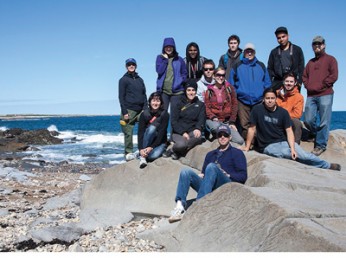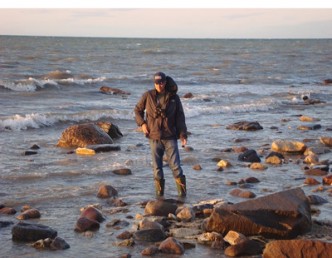New course takes students to subarctic Canada

Led by Peter Doran and Steven Forman, students took a trip to subarctic Canada for a new course. Photo: Jorge Barerra
They saw beluga whales, caribou, arctic hares, arctic foxes and “tons of birds,” including snow geese.
But no polar bears, even in “the world’s largest birthing ground and denning territory” for the creatures.
That may have been the only disappointment during a nine-day trip to subarctic Canada in August, led by Peter Doran and Steven Forman, professors of earth and environmental sciences, for a new course called “Field Experience in Earth Sciences.”
“I enjoyed being able to teach students, in the field, the real-time Arctic processes that are a challenge to convey through PowerPoint,” Forman said.
The expedition included a teaching assistant and 11 students.
“It’s probably the most beautiful place I’ve ever been in my life,” said graduate student Kyle Cronin.
In the area near Churchill, Manitoba, the explorers saw snow geese and Arctic terns.
But they spied no polar bears, although they talked to a woman who’d seen one get dart-tranquilized from a helicopter before being hauled off.
“Any that wander into town are kept there” until they can be returned to the wild, Doran said. “They don’t let anyone see them because they don’t want them to get used to humans.”
Experiencing beluga whales was a highlight of the trip.
“There was an endless stream coasting by, 100 feet from where we sat eating lunch,” Doran said.
Another high point was the hours spent viewing the Northern Lights.
“It was the best show I’ve ever seen,” he said.
The group saw glacial deposits from 15,000 years ago, a time when what is now Chicago was covered by ice.
All is permafrost, 2 miles thick.
“This area will see no impact from rising sea levels in the near future,” Doran said.
Doran, whose current research concerns the ecosystem of the Antarctic, did his first fieldwork in such an area 25 years ago.
“For me it was magical, it took me back to my roots,” he said of the trip. “The Arctic and subarctic is my bread and butter.”

Peter Doran did his first fieldwork in Antarctica 25 years ago. “For me it was magical, it took me back to my roots,” he said of the trip. Photo: Steven Forman
Forman is a paleoclimatologist who studies landscape response and human adaptation to environmental and climate change, using various dating methods to quantify the timing and pace of changes.
It took two days to reach the site by train, rocking back and forth at 15 mph.
“Four days of that is quite a bit,” Doran said. “I wouldn’t do it again, but I’d recommend that anyone do it once.”
The two professors said they’d like to offer the course every other year.
“Students learn more in the field, immersed in the science,” Forman said.
For Kathy Langfoss, a senior in earth and environmental science, the trip was an extraordinary experience.
“Being on the tundra was very different from anywhere I’ve ever been,” she said.
“To see a true permafrost environment was great,” Cronin said.
“It sorta feels like you’re walking on the moon.”
